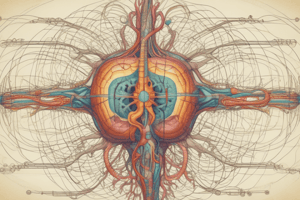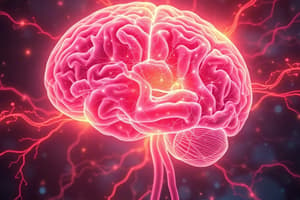Podcast
Questions and Answers
Cranial nerves arise from the spinal cord segments.
Cranial nerves arise from the spinal cord segments.
False (B)
The autonomic nervous system consists of the brain and the spinal cord.
The autonomic nervous system consists of the brain and the spinal cord.
False (B)
The spinal cord has 8 cervical segments only.
The spinal cord has 8 cervical segments only.
False (B)
The Autonomic Nervous System can be divided into the Sympathetic Nervous System and the Parasympathetic Nervous System.
The Autonomic Nervous System can be divided into the Sympathetic Nervous System and the Parasympathetic Nervous System.
The autonomic nervous system is responsible for communication between the CNS and the rest of the body.
The autonomic nervous system is responsible for communication between the CNS and the rest of the body.
Both Sympathetic and Parasympathetic Nervous Systems involve regulation of the 'external' environment under conscious control.
Both Sympathetic and Parasympathetic Nervous Systems involve regulation of the 'external' environment under conscious control.
There are 2 big initial divisions of the nervous system: Central Nervous System and Cerebellum.
There are 2 big initial divisions of the nervous system: Central Nervous System and Cerebellum.
Sympathetic ganglia are also known as terminal ganglia.
Sympathetic ganglia are also known as terminal ganglia.
The autonomic nervous system includes cholinergic receptors.
The autonomic nervous system includes cholinergic receptors.
In the Autonomic Nervous System, a collection of nerve cells lying outside the central nervous system is termed a nucleus.
In the Autonomic Nervous System, a collection of nerve cells lying outside the central nervous system is termed a nucleus.
The site of action of drugs used to control autonomic functions is primarily at the autonomic ganglia.
The site of action of drugs used to control autonomic functions is primarily at the autonomic ganglia.
Cranial nerves are directly involved in the regulation of autonomic functions through their connections to autonomic ganglia.
Cranial nerves are directly involved in the regulation of autonomic functions through their connections to autonomic ganglia.
The Sensory Division of the Peripheral Nervous System conducts impulses from the CNS to effectors.
The Sensory Division of the Peripheral Nervous System conducts impulses from the CNS to effectors.
Motor Efferent Division of the Autonomic Nervous System is generally voluntary.
Motor Efferent Division of the Autonomic Nervous System is generally voluntary.
The Autonomic Nervous System controls skeletal muscles.
The Autonomic Nervous System controls skeletal muscles.
The Somatic nervous system has a two-neuron efferent pathway.
The Somatic nervous system has a two-neuron efferent pathway.
Acetylcholine (Ach) is exclusively the neurotransmitter at the end of postganglionic neurons in the Autonomic Nervous System.
Acetylcholine (Ach) is exclusively the neurotransmitter at the end of postganglionic neurons in the Autonomic Nervous System.
The Somatic nervous system can lead only to muscle excitation.
The Somatic nervous system can lead only to muscle excitation.




